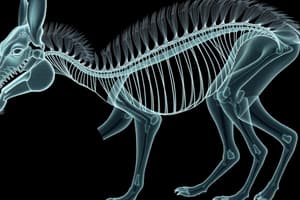Podcast
Questions and Answers
Which of the following phyla includes jellyfish and corals?
Which of the following phyla includes jellyfish and corals?
- Mollusca
- Nematoda
- Porifera
- Cnidaria (correct)
What percentage of all animal species are invertebrates?
What percentage of all animal species are invertebrates?
- 85%
- 75%
- 95% (correct)
- 100%
Which of the following characteristics defines vertebrates?
Which of the following characteristics defines vertebrates?
- Are exclusively land animals
- Presence of a backbone (correct)
- Always have fur or feathers
- Lack a backbone
What type of animals are included in the phylum Chordata?
What type of animals are included in the phylum Chordata?
Which of the following phyla includes snails, clams, and squids?
Which of the following phyla includes snails, clams, and squids?
Which of the following phyla consists solely of invertebrate animals?
Which of the following phyla consists solely of invertebrate animals?
Which group of animals is classified under the phylum Arthropoda?
Which group of animals is classified under the phylum Arthropoda?
What type of worms are classified under the phylum Annelida?
What type of worms are classified under the phylum Annelida?
Which phylum includes flatworms, tapeworms, and flukes?
Which phylum includes flatworms, tapeworms, and flukes?
What distinguishes invertebrate animals from vertebrate animals?
What distinguishes invertebrate animals from vertebrate animals?
All animals are classified into less than 30 phyla.
All animals are classified into less than 30 phyla.
The phylum Cnidaria includes animals such as jellyfish and corals.
The phylum Cnidaria includes animals such as jellyfish and corals.
Vertebrates account for at least 95 percent of all animal species.
Vertebrates account for at least 95 percent of all animal species.
Sponges belong to the phylum Mollusca.
Sponges belong to the phylum Mollusca.
All members of the phylum Chordata have a vertebral column.
All members of the phylum Chordata have a vertebral column.
Nematoda is the phylum that includes roundworms.
Nematoda is the phylum that includes roundworms.
Earthworms are classified as members of the phylum Annelida.
Earthworms are classified as members of the phylum Annelida.
Arthropoda includes insects, spiders, and centipedes.
Arthropoda includes insects, spiders, and centipedes.
Marine worms belong to the phylum Echinodermata.
Marine worms belong to the phylum Echinodermata.
Flatworms, tapeworms, and flukes are found in the phylum Platyhelminthes.
Flatworms, tapeworms, and flukes are found in the phylum Platyhelminthes.
Flashcards are hidden until you start studying
Study Notes
Classification of Animals
- Animals are classified into over 30 phyla based on shared traits and diversity.
- Estimated over a million species of animals exist on Earth, showcasing vast diversity from simple to complex organisms.
Major Animal Phyla
- Phyla listed contain at least 10,000 species each:
- Porifera: Includes sponges.
- Cnidaria: Comprises jellyfish and corals.
- Platyhelminthes: Contains flatworms, tapeworms, and flukes.
- Nematoda: Consists of roundworms.
- Mollusca: Includes snails, clams, and squids.
- Annelida: Comprises earthworms, leeches, and marine worms.
- Arthropoda: Includes insects, spiders, crustaceans, and centipedes.
- Echinodermata: Contains sea stars, sea urchins, sand dollars, and sea cucumbers.
- Chordata: Encompasses tunicates, lancelets, fish, amphibians, reptiles, birds, and mammals.
Invertebrates vs. Vertebrates
- The first eight phyla are exclusively invertebrates, lacking a backbone or vertebral column.
- Phylum Chordata includes both vertebrate and invertebrate species, such as tunicates and lancelets.
- Invertebrates constitute at least 95% of all animal species.
- Vertebrates, which have a backbone, are all classified under the phylum Chordata.
- Vertebrate groups include fish, amphibians, reptiles, birds, and mammals.
Classification of Animals
- Animals are classified into over 30 phyla based on shared traits and diversity.
- Estimated over a million species of animals exist on Earth, showcasing vast diversity from simple to complex organisms.
Major Animal Phyla
- Phyla listed contain at least 10,000 species each:
- Porifera: Includes sponges.
- Cnidaria: Comprises jellyfish and corals.
- Platyhelminthes: Contains flatworms, tapeworms, and flukes.
- Nematoda: Consists of roundworms.
- Mollusca: Includes snails, clams, and squids.
- Annelida: Comprises earthworms, leeches, and marine worms.
- Arthropoda: Includes insects, spiders, crustaceans, and centipedes.
- Echinodermata: Contains sea stars, sea urchins, sand dollars, and sea cucumbers.
- Chordata: Encompasses tunicates, lancelets, fish, amphibians, reptiles, birds, and mammals.
Invertebrates vs. Vertebrates
- The first eight phyla are exclusively invertebrates, lacking a backbone or vertebral column.
- Phylum Chordata includes both vertebrate and invertebrate species, such as tunicates and lancelets.
- Invertebrates constitute at least 95% of all animal species.
- Vertebrates, which have a backbone, are all classified under the phylum Chordata.
- Vertebrate groups include fish, amphibians, reptiles, birds, and mammals.
Studying That Suits You
Use AI to generate personalized quizzes and flashcards to suit your learning preferences.




